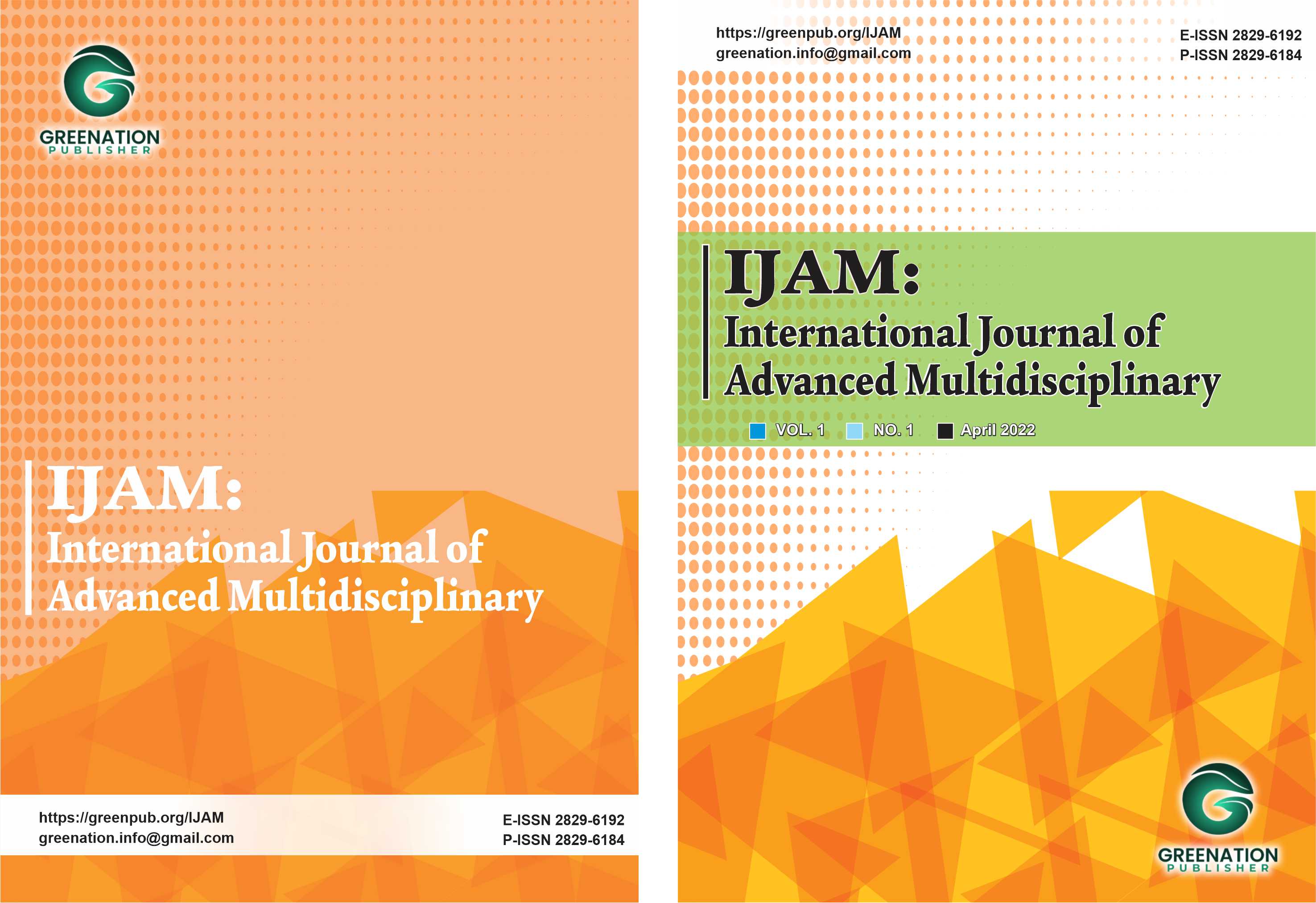Pb Heavy Metal Content, Growth and Yield of Four Kale Varieties (Ipomea reptans Poir.) due to Dosage of Chicken Manure with Sediment Media of Sewers
DOI:
https://doi.org/10.38035/ijam.v2i4.429Keywords:
Chicken Manure, Heavy Metal Content, Kale Varieties, Sewer Sediment MediaAbstract
Food insecurity is a condition in an area, community or household where the level of security and availability does not meet the standards needed for the growth and health of the majority of the population. Kangkung is a heavy metal-absorbing weed plant that many people like as a vegetable. Food security in urban communities is limited by existing land and growing media, so using media from sewer sediment is an alternative. The experiment used a factorial Randomized Block Design (RAK), consisting of two factors, namely the dose of chicken manure (A) with 4 levels as follows: a0 : 0 t ha-1 (control), a1 : 10 t ha-1, a2 : 20 t ha-1 and a3 : 30 t ha-1 and Kangkung Variety (K) with 4 levels as follows: k0 : Serimpi Variety, k1 : Amanda Variety, k2 : Bangkok LP-1 Variety and k3 : Bika Variety, so there are 16 treatment combinations repeated 2 times. The research findings indicated that there was no significant correlation between the dosage of chicken manure and the plant type in terms of plant growth, yield, and absorption of PB heavy metals, with the exception of leaf count. The optimum dose of chicken manure is 5.05 t ha-1 in the Serimpi variety with a maximum number of leaves of 11.30 plants-1, 5.27 t ha-1 in the Amanda variety produces a maximum number of leaves of 16.68 plants-1 , 9.20 t ha-1 in the Bangkok LP-1 variety produces a maximum number of leaves of 16.77 plants-1 and 3.83 t ha-1 in the Bika variety produces a maximum number of leaves of 18.66 plants-1.
References
Anggia, E. V. and Hamidah, I. 2019. Morphological Sanitation Level of Ipomoea sp. (Kangkung) as an ingredient for consumption by the people of Indramayu. Proceedings of the National Mathematics and Science Seminar, (September): 98–101. https://prosiding.biounwir.ac.id/article/view/17. DOI: https://doi.org/10.5281/zenodo.3648332
Aprilia, E. et al. 2020. Growth and Yield of Pakchoy Plants on Sandy Soil Using Biochar and Chicken Manure. Growth and Yield of Pakchoy on Sandy Soil by Using Biochar and Cow Manure Fertilizer, 22(2): 72–78. doi: http://dx.doi.org/10.20961/agsjpa.v22i2.42093.
Bhoki, M., Jeksen, J. and Beja, H. D. 2021. The Effect of Providing Chicken Manure on the Growth and Yield of Green Mustard Plants (Brassica juncea L.). Journal of Agro Wiralodra (4)2: 64-68. https://agrowiralodra.unwir.ac.id/index.php/agrowiralodra/article/view/67.
https://doi.org/10.31943/agrowiralodra.v4i2.67.
Elawati, Kandowangko, N. Y. and Lamondo, D. 2018. Efficiency of absorption of the heavy metal copper (Cu) by water spinach plants (Ipomoae aquatica forks) with different contact times. Radial – Journal of Science, Engineering and Technology Civilization, 6(2):162–166. https://stitek-binataruna.e-journal.id/radial/article/view/175. DOI: https://doi.org/10.37971/radial.v6i2.175
Gaso, M.T. et al. (2022) 'Growth Response of Ground Water Spinach (Ipomea reptans Poir) after Giving Rice Husk Charcoal', Journal of Biology and Biology Education. doi: http://dx.doi.org/10.55241/spibio.v3i2.59.
Jeanine Arana, Stephen L. Meyers, Wenjing Guan and William G. Johnson. 2022. Interference of morningglories (Ipomoea spp.) with triploid watermelon ‘Fascination’. Published online by Cambridge University Press. https://www.cambridge.org/core/journals/weed-science/article/interference-of-morningglories-ipomoea-spp-with-fascination-triploid-watermelon/F37CD36E0A5FFACCEB5D858B324E93D6. DOI: https://doi.org/10.1017/wsc.2022.35
Hailong Mao, Ke Wang, Zhe Wang, Jing Peng, Nanqi Ren. 2020. Metabolic function, trophic mode, organics degradation ability and influence factors of bacterial and fungal communities in chicken manure composting. Bioresour. Technol. 122883. National Library of Medicine. National Center for Biotechnology Information. https://pubmed.ncbi.nlm.nih.gov/32006923/
doi: 10.1016/j.biortech.2020.122883.
Juhri, D. A. 2017. The Effect of Heavy Metals (Cadmium, Chromium, and Lead) on Reducing the Wet Weight of Water Spinach (Ipomoea aquatica Forsk) as Extension Material for Vegetable Farmers. Journal of Education Lantern Research Center Lppm Um Metro (2) 2: 219-229
https://ojs.ummetro.ac.id/index.php/lentera/article/view/708. DOI: http://dx.doi.org/10.24127/jlpp.v2i2.708
Ministry of Agriculture. 2018. Regulation of the Minister of Agriculture of the Republic of Indonesia Number 53/PERMENTAN/KR.040/12/2018 concerning Safety and Quality of Fresh Food of Plant Origin. https://peraturan.bpk.go.id> download
Luqman Riaz, Qianqian Wang, Qingxiang Yang, Xunan Li, Wei Yuan. 2020. Potential of industrial composting and anaerobic digestion for the removal of antibiotics, antibiotic resistance genes and heavy metals from chicken manure. Science of The Total Environment (718), 137414. Elsevier. https://www.sciencedirect.com/science/article/abs/pii/S0048969720309244?via%3Dihub.
https://doi.org/10.1016/j.scitotenv.2020.137414
Maisarah and Fitria, D. 2022. The Effect of Dosing Guano Fertilizer on the Growth and Yield of Several Varieties of Water Spinach (Ipomea aquatica). Journal of Sustainable Agriculture, 10(1): 137-146. https://e-journal.my.id/perbal/article/view/1611/1287. DOI: https://doi.org/10.30605/perbal.v10i1.1611. ISSN 2302-6944, e-ISSN 2581-1649.
Andi Nadila, Gamar B.N. Shamdas, Lestari, M.P. Alibasyah and Masrianih. 2021. Effect of Chicken Manure Dosage on the Growth and Yield of Ground Water Spinach Plants (Ipomoea reptans Poir.) and Its Use as a Learning Media, Journal of Biology Science and Education (JBSE), 9(2): 814–819. https://www.scribd.com/document/635942641/Untitled#. doi: http://jurnal.fkip.untad.ac.id.
Ramdhan, M., Nafiaah, H.H. and Swardana, A. 2021. Effect of Chicken Manure Dosage and Trichoderma sp. on the Growth and Yield of Ground Water Spinach (Ipomoea reptans Poir.). Journal of Agrotechnology and Science (Journal of Agrotechnology Science). JAGROS (6)1 : 52-64. https://journal.uniga.ac.id/index.php/JPP/article/view/1619
Rokhmah, N. A., Rahman, M. and Sastro, Y. (2020) 'Ammonia Reduction by Land Water Spinach (Ipomea reptans) in Fish Cultivation Using Vertiminaponic Technology', AGROPROSS (4): 8-9, https://proceedings.polije .ac.id/index.php/agropross/article/view/9. doi: 10.25047/agropross.2020.9.
Rompegading, A. B. , Muhlis, N.F, Arfadilla, R., et.al. .2021. Initial Detection of Copper Metal (Cu) Content in Land Water Spinach Plants (Ipomoea reptans). BIOEDUSAINS: Journal of Biology and Science Education (4) : 246–250. https://journal.ipm2kpe.or.id/index.php/BIOEDUSAINS/article/view/2790. doi: https://doi.org/10.31539/bioedusains.v4i2.2790.
Sajuri S, Mawaripta, H.D., Supriyanto, E.A, and Jazilah S. 2022. Growth Response of Water Spinach Plants (Ipomoea reptans Poir) to the Treatment of Number of Seeds and Nutrients with the Axis Hydroponic System in Coastal Areas. Agrotek : Scientific Journal of Agricultural Sciences 6(1) : 83–89. https://jurnal.fp.umi.ac.id/index.php/agrotek/article/view/178 DOI: https://doi.org/10.33096/agrotek.v6i1.178
Shihang Wu, Dina Tursenjan, Yuebing Sun. 2023. Impact of compost methods on humification and heavy metal passivation during chicken manure composting. Journal of Environmental Management (325) Part B, 116573 Elsevier. Science Direct. https://www.sciencedirect.com/science/article/abs/pii/S0301479722021466?via%3Dihub. https://doi.org/10.1016/j.jenvman. 22022.116573
Suwartini, N.K.S. and Anggia. 2021. The Effect of Application of Different Doses of Goat Manure on the Growth and Production of Curly Chili Plants. Effect of Different Doses of Goat Manure on Growth and Production of Curly Chili (Capcisum annum L.), Agriyan Journal: Unidayan Agrotechnology Journal 7(2):8-15. eISSN 2808 - 8077 pISSN 2407 - 1099 . https://ejournal.lppmunidayan.ac.id>download.
Suhaeni and Wardi, R. Y. 2016. Analysis of Heavy Metal Cadmium (Cd) Levels in Ground Water Spinach Plants (Ipomoea reptans Poir), Dynamics, 07(2):1–8. P-ISSN: 2087 – 7889 E-ISSN: 2503 – 4863. https://journal.uncp.ac.id>article>view
Wenwen Deng, Anyun Zhang, Shujuan Chen, Xueping He, Lei Jin, Xiumei Yu, Shengzhi Yang, Bei Li, Liangqian Fan, Lin Ji, Xin Pan, Likou Zou. 2020. Heavy metals, antibiotics and nutrients affect the bacterial community and resistance genes in chicken manure composting and fertilized soil. Journal of Environmental Management (257), 109980. Elsevier. https://www.sciencedirect.com/science/article/abs/pii/S0301479719316986?via%3Dihub. https://doi.org/10.1016/j.jenvman.2019.109980
Xiaomeng Chen, Zhuang Du, Tong Guo, Junqiu Wu, Bo Wang, Zimin Wei, Limimg Jia, Kejia Kang. 2022. Effects of heavy metals stress on chicken manure composting via the perspective of microbial community feedback. Environmental Pollution (294), 118621. https://www.sciencedirect.com/science/article/abs/pii/S0269749121022065?via%3Dihub. https://doi.org/10.1016/j.envpol.2021.118624.
Ying Zhang, Qinghong Sun, Jianmin Wang, Yuexuan Ma, Bo Cao. 2021. Responses of heavy metals mobility and resistant bacteria to adding time of activated carbon during chicken manure composting. Environmental Pollution (290), 118070. Elsevier. https://www.sciencedirect.com/science/article/abs/pii/S0269749121016523?via%3Dihub. https://doi.org/10.1016/j.envpol.2021.118070
Downloads
Published
How to Cite
Issue
Section
License
Copyright (c) 2024 Lia Amalia Lia Amalia, Nunung Sondari, Budiasih, Tien Turmuktini, Elly Roosma Ria, Kovertina Rakhmi Indriana, Beni Komara

This work is licensed under a Creative Commons Attribution 4.0 International License.
Authors who publish their manuscripts in this journal agree to the following conditions:
- The copyright on each article belongs to the author(s).
- The author acknowledges that the International Journal of Advanced Multidisciplinary (IJAM) has the right to be the first to publish with a Creative Commons Attribution 4.0 International license (Attribution 4.0 International (CC BY 4.0).
- Authors can submit articles separately, arrange for the non-exclusive distribution of manuscripts that have been published in this journal into other versions (e.g., sent to the author's institutional repository, publication into books, etc.), by acknowledging that the manuscript has been published for the first time in the International Journal of Advanced Multidisciplinary (IJAM).























